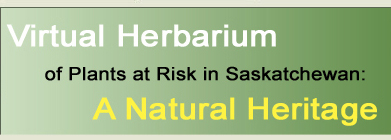|
| Elymus lanceolatus
ssp. psammophilus (Gillett & Senn) A. Löve |
|
| |
| TAXONOMY |
| |
| Family: |
Poaceae |
| Genus: |
Elymus |
| |
| Species Synonyms: |
Agropyron psammophilum Gillett &
Senn
Agropyron dasystachyum var. psammophilum (Gillett
& Senn) E.G. Voss
Agropyron dasystachyum ssp. psammophilum
(Gillett & Senn) D.R. Dewey |
| Common Names: |
sand-dune wheatgrass
streambank wheatgrass |
| |
| DISTRIBUTION |
| |
| Canada: |
central Saskatchewan – southwestern Manitoba,
southern Ontario |
| Saskatchewan: |
southern Saskatchewan; Saskatoon – Elbow
Sand Hills – Corning |
| Ecoregion: |
Moist Grassland, Moist Mixed Grassland, Aspen
Parkland |
| |
| HABITAT |
| |
| Saskatchewan: |
active sand dune blowouts |
| Associated species: |
Achnatherum hymenoides, Calamovilfa longifolia,
Psoralidium lanceolatum, Sporobolus cryptandrus |
| |
| RARITY STATUS |
| |
Provincial
Status According
to Harms (2003): |
Threatened |
| Nature Conservancy
Status: |
G5T3 T2 |
Saskatchewan
Species at
Risk Status: |
Vulnerable (DD) |
| COSEWIC Status:
|
None |
| |
| Elymus lanceolatus
ssp. psammophilus is threatened because it is rare in Saskatchewan and is
limited to sandy environments in the southern part of the province. Most
local populations are small. Possible threats have been identified but more
information is needed on this species. |
| |
| SPECIES
DESCRIPTION |
| |
| Height: |
40 – 110 cm |
| Roots: |
rhizomes long, creeping |
| Stems: |
perennial, erect, hollow, glaucous |
| Leaves: |
5 – 25 cm long, 1 – 4 mm wide, scabrous
or pilose to glabrous, usually involute; sheaths usually finely strigose;
ligules 0.1 – 0.6 mm long; auricles often present and conspicuous |
| Inflorescence: |
spikes compact, 3 – 25 cm long; rachis pubescent
below the spikelet |
| Spikelets: |
spikelets 1 per node, loosely to closely imbricate,
4 – 7-flowered |
| Florets: |
glumes 4 – 8 mm long, unequal, broadest
above the middle, apex acute to acuminate, conspicuously 5-nerved, pubescent
to glabrous, margin scarious; lemmas 6.5 – 10 mm long, densely villous,
may be awned; palea to 11 mm long, as long as lemma |
| Fruits: |
caryopsis |
| |
| ELYMUS
KEY FOR SPECIES FOUND IN SASKATCHEWAN |
| |
| 1 Spikelets 2 or 3 at each rachis
node, 1 – 6-flowered; lemmas obscurely 5-nerved |
2 |
| 1 Spikelets solitary at each rachis
node, each spikelet with at least 2 florets; lemmas 5 – 7-nerved |
8 |
| |
|
2 Glumes, if present, setaceous, divided
to base into 2 divergent awns; spike rachis readily disarticulating; plants
mostly 10 – 50 cm tall
|
E. elymoides ssp. elymoides |
| 2 Glumes setaceous or not; spike rachis
not readily disarticulating; plants mostly taller than 50 cm |
3 |
| |
|
| 3 Glume margins membranous, not nerved;
lemmas glabrous to scabrous |
E. glaucus ssp. glaucus |
| 3 Glume margins thickened, hard, and
nerved; lemmas densely pubescent |
4 |
| |
|
| 4 Glumes setaceous, reduced, or absent,
usually < 6 mm long (excluding awn) and 0.5 mm wide |
E. diversiglumis |
| 4 Glumes linear, usually at least
1 cm long (excluding awn) and 1 – 2 mm wide |
5 |
| |
|
| 5 Glumes shorter than lemma body;
lemma awns divergent at maturity; base of glume flattened |
6 |
| 5 Glumes equal to or longer than lemma
body; lemma awns straight at maturity; base of glume terete or bowed |
7 |
| |
|
| 6 Leaves firm, adaxially glabrous
or scabrous; spikes arching; palea to 1.1 cm long |
E. canadensis var. canadensis |
| 6 Leaves thin, adaxially pilose; spike
pendulous; palea to 1.5 cm long |
E. canadensis var. wiegandii |
| |
|
| 7 Glumes and lemmas long-awned (to
1.5 cm) |
E. virginicus var. virginicus |
| 7 Glumes and lemmas mucronate to short-awned
(< 2 mm) |
E. virginicus var. submuticus |
| |
|
| 8 Rhizomes short or absent; florets
disarticulating above the glumes; anthers 1.5 – 2 mm long |
9 |
| 8 Rhizomes long and creeping; florets
disarticulating below the glumes; anthers 3 – 7 mm long |
10 |
| |
|
| 9 Awns equal to or longer than lemma |
E. trachycaulus ssp. subsecundus |
| 9 Awns absent or much shorter than
lemma |
E. trachycaulus ssp. trachycaulus |
| |
|
| 10 Leaves flat, 4 – 8 mm wide,
green; lemmas glabrous or nearly so |
E. repens |
| 10 Leaves involute, 1 – 3 mm
wide, glaucous; lemmas usually pubescent |
11 |
| |
|
| 11 Glumes 2 – 3-nerved; lemmas
long-awned |
E. albicans |
| 11 Glumes 3 – 5-nerved; lemmas
awnless |
12 |
| |
|
| 12 Spikes to 25 cm long; rachis pubescent
below spikelets; glumes conspicuously 5-nerved; lemmas densely villous |
E. lanceolatus ssp. psammophilus |
| 12 Spikes to 15 cm long; rachis glabrous
below spikelets; glumes 3-nerved, only the midvein conspicuous; lemmas glabrous
or villous |
13 |
| |
|
| 13 Lemmas glabrous or scabrous |
E. lanceolatus ssp. lanceolatus
var. riparium |
| 13 Lemmas villous |
E. lanceolatus ssp. lanceolatus
var. lanceolatus |
| |
|
| *Elymus
hybrids occur naturally in Saskatchewan. E. X maltei (E.
canadensis x E.virginicus ) and E. X pseudorepens
(E. trachycaulus x E. lanceolatus) are examples. |
|
|






